Optimization of the Recycling Process for Aligned Short Carbon Fiber TuFF Composites
Abstract
1. Introduction
2. Results and Discussion
2.1. Non-Isothermal TGA
2.2. Isothermal TGA
2.3. Batch Pyrolysis
2.3.1. Lab Scale Dispersion and SEM Analysis
2.3.2. Single Fiber Tension Test
2.4. Composite Panel Processing and Analysis
2.4.1. C-Scan Analysis
2.4.2. Microscopy
2.4.3. Tensile Testing
3. Materials and Methods
3.1. Materials
3.2. Methodology
3.3. Thermal Cycle Optimization
3.3.1. Non-Isothermal TGA
3.3.2. Isothermal TGA
3.4. Scaling of Thermal Cycle for Fiber Recovery
3.4.1. Dispersion Analysis and Scanning Electron Microscopy
3.4.2. Single Fiber Tension Test
3.5. Composite Processing and Testing
3.5.1. TuFF Alignment Process
3.5.2. Resin Film Impregnation and Curing Process
3.5.3. Ultrasonic C-Scan and Microscopy
3.5.4. Mechanical Testing
4. Conclusions
Author Contributions
Funding
Data Availability Statement
Acknowledgments
Conflicts of Interest
References
- Stieven Montagna, L.; Ferreira de Melo Morgado, G.; Lemes, A.P.; Roberto Passador, F.; Cerqueira Rezende, M. Recycling of carbon fiber-reinforced thermoplastic and thermoset composites: A review. J. Thermoplast. Compos. Mater. 2022, 36, 3455–3480. [Google Scholar]
- Oliveux, G.; Dandy, L.O.; Leeke, G.A. Current status of recycling of fibre reinforced polymers: Review of technologies, reuse and resulting properties. Prog. Mater. Sci. 2015, 72, 61–99. [Google Scholar] [CrossRef]
- Khurshid, M.F.; Hengstermann, M.; Hasan, M.M.B.; Abdkader, A.; Cherif, C. Recent developments in the processing of waste carbon fibre for thermoplastic composites–A review. J. Compos. Mater. 2020, 54, 1925–1944. [Google Scholar]
- Pakdel, E.; Kashi, S.; Varley, R.J.; Wang, X. Recent progress in recycling carbon fibre reinforced composites and dry carbon fibre wastes. Resour. Conserv. Recycl. 2020, 166, 105340. [Google Scholar] [CrossRef]
- Bao, L.; Sun, Y.; Ruan, F.; Murakami, Y.; Yu, Y. Development of a method for recycling factory waste carbon fiber prepregs and increasing the added value of the collected material. Polym. Compos. 2023, 44, 2071–2079. [Google Scholar]
- Naqvi, S.R.; Prabhakara, H.M.; Bramer, E.; Dierkes, W.K.; Akkerman, R.; Brem, G. A critical review on recycling of end-of-life carbon fibre/glass fibre reinforced composites waste using pyrolysis towards a circular economy. Resour. Conserv. Recycl. 2018, 136, 118–129. [Google Scholar]
- Salas, A.; Berrio, M.E.; Martel, S.; Díaz-Gómez, A.; Palacio, D.A.; Tuninetti, V.; Medina, C.; Meléndrez, M.F. Towards recycling of waste carbon fiber: Strength, morphology and structural features of recovered carbon fibers. Waste Manag. 2023, 165, 59–69. [Google Scholar] [CrossRef]
- Hagnell, M.K.; Åkermo, M. The economic and mechanical potential of closed loop material usage and recycling of fibre-reinforced composite materials. J. Clean. Prod. 2019, 223, 957–968. [Google Scholar] [CrossRef]
- Pimenta, S.; Pinho, S.T. Recycling carbon fibre reinforced polymers for structural applications: Technology review and market outlook. Waste Manag. 2011, 31, 378–392. [Google Scholar] [CrossRef]
- Fitzgerald, A.M.; Wong, N.; Fitzgerald, A.; Jesson, D.A.; Martin, F.; Murphy, R.J.; Young, T.; Hamerton, I.; Longana, M.L. Life Cycle Assessment of the High Performance Discontinuous Fibre (HiPerDiF) Technology and Its Operation in Various Countries. Sustainability 2022, 14, 1922. [Google Scholar] [CrossRef]
- Guo, W.; Bai, S.; Ye, Y.; Zhu, L. Recycling carbon fiber-reinforced polymers by pyrolysis and reused to prepare short-cut fiber C/C composite. J. Reinf. Plast. Compos. 2019, 38, 340–348. [Google Scholar]
- López, F.A.; Rodríguez, O.; Alguacil, F.J.; García-Díaz, I.; Centeno, T.A.; García-Fierro, J.; González, C. Recovery of carbon fibres by the thermolysis and gasification of waste prepreg. J. Anal. Appl. Pyrolysis 2013, 104, 675–683. [Google Scholar] [CrossRef]
- Kim, H.H.; Kim, B. Recovery of carbon fibers from carbon fiber-reinforced epoxy-isophorone diamine composites via step thermolysis. Compos. Part B Eng. 2023, 260, 110757. [Google Scholar]
- Lopez-Urionabarrenechea, A.; Gastelu, N.; Acha, E.; Caballero, B.M.; Orue, A.; Jiménez-Suárez, A.; Prolongo, S.; Marco, I.D. Reclamation of carbon fibers and added-value gases in a pyrolysis-based composites recycling process. J. Clean. Prod. 2020, 273, 123173. [Google Scholar]
- Hanaoka, T.; Ikematsu, H.; Takahashi, S.; Ito, N.; Ijuin, N.; Kawada, H.; Arao, Y.; Kubouchi, M. Recovery of carbon fiber from prepreg using nitric acid and evaluation of recycled CFRP. Compos. Part B Eng. 2022, 231, 109560. [Google Scholar] [CrossRef]
- Karuppannan Gopalraj, S.; Kärki, T. A Study to Investigate the Mechanical Properties of Recycled Carbon Fibre/Glass Fibre-Reinforced Epoxy Composites Using a Novel Thermal Recycling Process. Processes 2020, 8, 954. [Google Scholar] [CrossRef]
- Such, M.C.; Ward, C.; Potter, K. Aligned Discontinuous Fibre Composites: A Short History. J. Multifunct. Compos. 2014, 2, 113–126. [Google Scholar] [CrossRef][Green Version]
- Tierney, J.J.; Crane, R.M.; Blackwell, C. Short Fiber TuFF Technology for Automotive Part Production via Wet Compression. In Proceedings of the SAMPE 2022, Charlotte, NC, USA, 23 May 2022. [Google Scholar]
- Yu, H.; Potter, K.; Wisnom, M.R. A novel manufacturing method for aligned discontinuous fibre composites (High Performance-Discontinuous Fibre method). Compos. Part A Appl. Sci. Manuf. 2014, 65, 175–185. [Google Scholar] [CrossRef]
- Aravindan, P.; Becagli, F.; Longana, M.L.; Blok, L.G.; Pozegic, T.R.; Huntley, S.J.; Rendall, T.C.; Hamerton, I. Remanufacturing of Woven Carbon Fibre Fabric Production Waste into High Performance Aligned Discontinuous Fibre Composites. J. Compos. Sci. 2020, 4, 68. [Google Scholar] [CrossRef]
- Longana, M.L.; Yu, H.; Potter, K. The High Performance Discontinuous Fibre (HiPerDiF) Method for the Remanu-facturing of Mixed Length Rreclaimed Carbon Fibres. In Proceedings of the 21st International Conference on Composite Materials, Xi’an, China, 20–25 August 2017. [Google Scholar]
- Longana, M.L.; Ong, N.; Yu, H.; Potter, K. Multiple closed loop recycling of carbon fibre composites with the HiPerDiF (High Performance Discontinuous Fibre) method. Compos. Struct. 2016, 153, 271–277. [Google Scholar] [CrossRef]
- Tapper, R.J.; Longana, M.L.; Yu, H.; Hamerton, I.; Potter, K. Development of a closed-loop recycling process for discontinuous carbon fibre polypropylene composites. Compos. Part B Eng. 2018, 146, 222–231. [Google Scholar] [CrossRef]
- Hamerton, I.; Sullivan, P.; Eichhorn, S.; Summers, V. Influence of Fibre Length Distribution on the Processing of Aligned Discontinuous Reclaimed Carbon Fibre Material. In Proceedings of the SAMPE 2024, Long Beach, CA, USA, 20–23 May 2024. [Google Scholar] [CrossRef]
- Turner, T.A.; Warrior, N.A.; Pickering, S. Development of high value moulding compounds from recycled carbon fibres. Plast. Rubber Compos. 2010, 39, 151–156. [Google Scholar] [CrossRef]
- Ozdemir, T.; Deitzel, J.M.; Crane, R.; Yarlagadda, S.; Blackwell, C.; Davis, M.; Emmerich, R.; Heider, D. Carbon Fiber Composites Recycling Technology Enabled by the TuFF Technology. Recycling 2024, 9, 11. [Google Scholar] [CrossRef]
- He, D.; Soo, V.K.; Stojcevski, F.; Lipiński, W.; Henderson, L.C.; Compston, P.; Doolan, M.C. The effect of sizing and surface oxidation on the surface properties and tensile behaviour of recycled carbon fibre: An end-of-life perspective. Compos. Part A Appl. Sci. Manuf. 2020, 138, 106072. [Google Scholar]
- Mazzocchetti, L.; Benelli, T.; D’Angelo, E.; Leonardi, C.; Zattini, G.; Giorgini, L. Validation of carbon fibers recycling by pyro-gasification: The influence of oxidation conditions to obtain clean fibers and promote fiber/matrix adhesion in epoxy composites. Compos. Part A Appl. Sci. Manuf. 2018, 112, 504–514. [Google Scholar] [CrossRef]
- Feih, S.; Mouritz, A.P.; Case, S.W. Determining the mechanism controlling glass fibre strength loss during thermal recycling of waste composites. Compos. Part A Appl. Sci. Manuf. 2015, 76, 255–261. [Google Scholar] [CrossRef]
- Xu, M.; Meng, X.; Ji, H.; Yang, J.; Di, J.; Wu, Y.; Lu, Q. Evolution of pyrolysis char during the recovery of carbon fiber reinforced polymer composite and its effects on the recovered carbon fiber. J. Environ. Chem. Eng. 2024, 12, 112214. [Google Scholar]
- Chen, B.R.; Parambil, N.K.; Deitzel, J.M.; Gillespie, J.W.; Vo, L.T.; Sarosi, P.M. Interfacial Shear Strength (IFSS) and Absorbed Energy Versus Temperature in Carbon Fiber-Thermoplastic Composites via Single Fiber Pullout Testing. In Proceedings of the American Society for Composites—Thirty-Fifth Technical Conference, Virtual, 14–17 September 2020. [Google Scholar]
- Cycom Cytec 977-3. 2022. Available online: www.solvay.com (accessed on 1 July 2024).
- HexTow® IM7 Carbon Fiber. 2023. Available online: http://www.hexcel.com (accessed on 1 July 2024).
- Chen, S.; Cao, X.; Zu, L.; He, J.; Zhang, Q.; Ren, P.; Zhang, G.; Wu, Q.; Fu, J.; Zhou, L. Optimisation of recycling process parameters of carbon fibre in epoxy matrix composites. Compos. Struct. 2023, 315, 116995. [Google Scholar] [CrossRef]
- Yarlagadda, S.; Deitzel, J.M.; Heider, D.; Tierney, J.J.; Gillespie, J. Tailorable Universal Feedstock for Forming (TUFF): Overview and Performance. In Proceedings of the SAMPE 2019, Charlotte, NC, USA, 20–23 May 2019. [Google Scholar]
- ASTM C1557-20; Standard Test Method for Tensile Strength and Young’s Modulus of Fibers. ASTM International: West Conshohocken, PA, USA, 2020. [CrossRef]
- Balaga, U.K.; Gargitter, V.; Crane, R.M.; Tierney, J.C.; Yarlagadda, S.; Heider, D.; Advani, S.G. Characterization and comparison of thin ply IM7/8552 composites processed by automated tape placement and hand layup. J. Compos. Mater. 2023, 57, 2243–2260. [Google Scholar] [CrossRef]
- Schindelin, J.; Arganda-Carreras, I.; Frise, E.; Kaynig, V.; Longair, M.; Pietzsch, T.; Preibisch, S.; Rueden, C.; Saalfeld, S.; Schmid, B.; et al. Fiji: An open-source platform for biological-image analysis. Nat. Methods 2012, 9, 676–682. [Google Scholar] [CrossRef]
- ASTM D3039/D3039M-17; Standard Test Method for Tensile Properties of Polymer Matrix Composite Materials. ASTM International: West Conshohocken, PA, USA, 2017. [CrossRef]
- Hecker, M.D.; Longana, M.L.; Eloi, J.; Thomsen, O.T.; Hamerton, I. Recycling end-of-life sails by carbon fibre reclamation and composite remanufacture using the HiPerDiF fibre alignment technology. Compos. Part A Appl. Sci. Manuf. 2023, 173, 107651. [Google Scholar] [CrossRef]

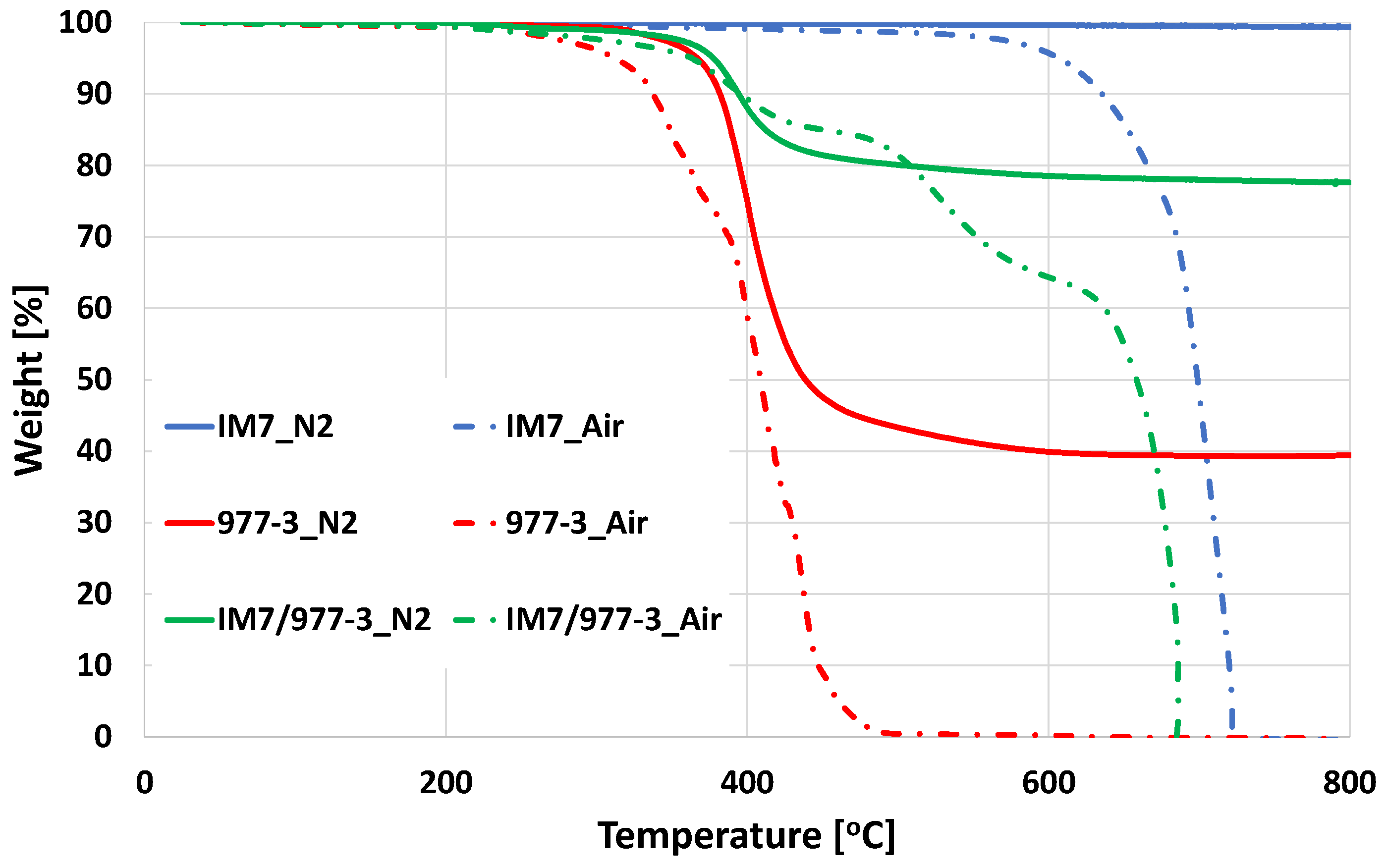
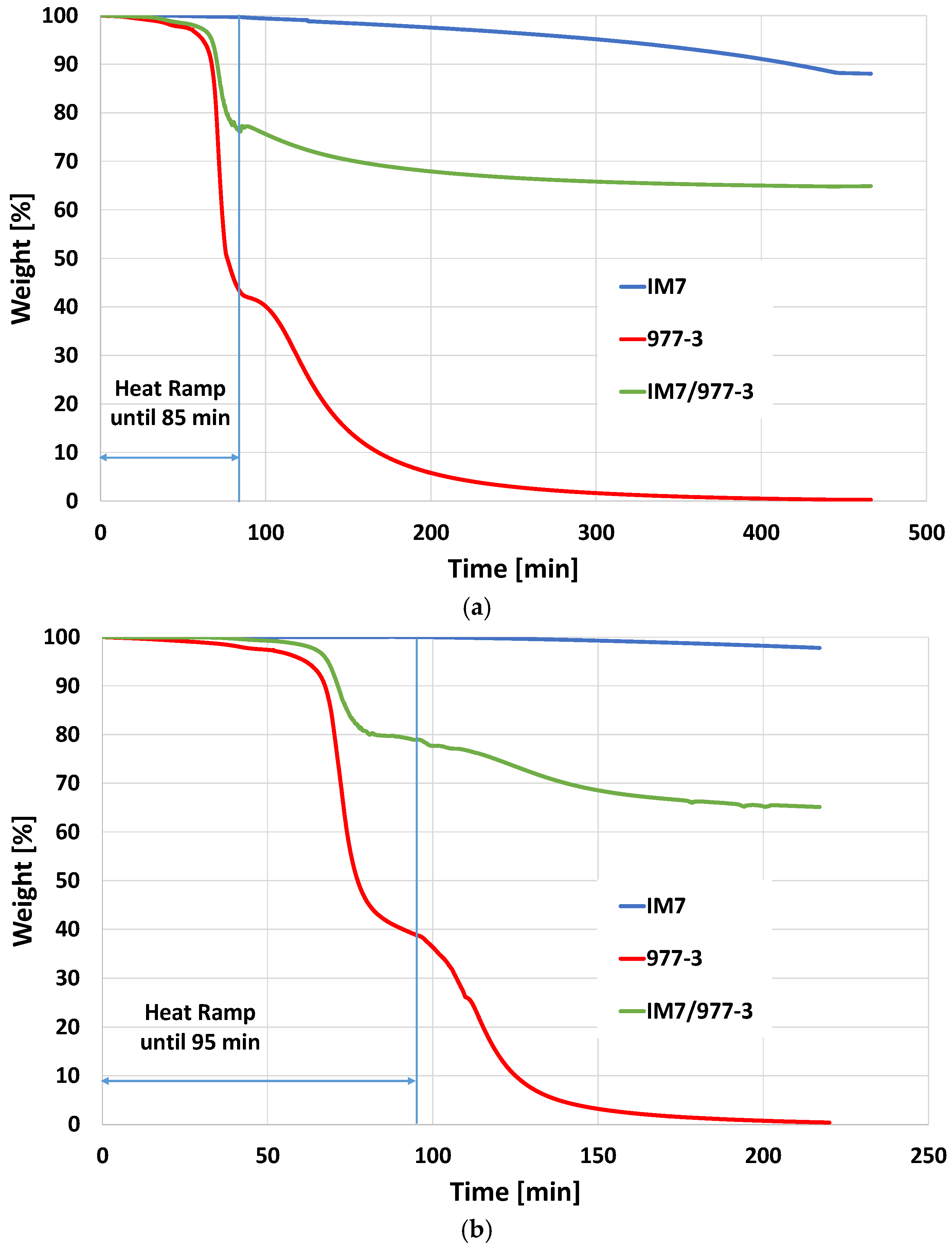
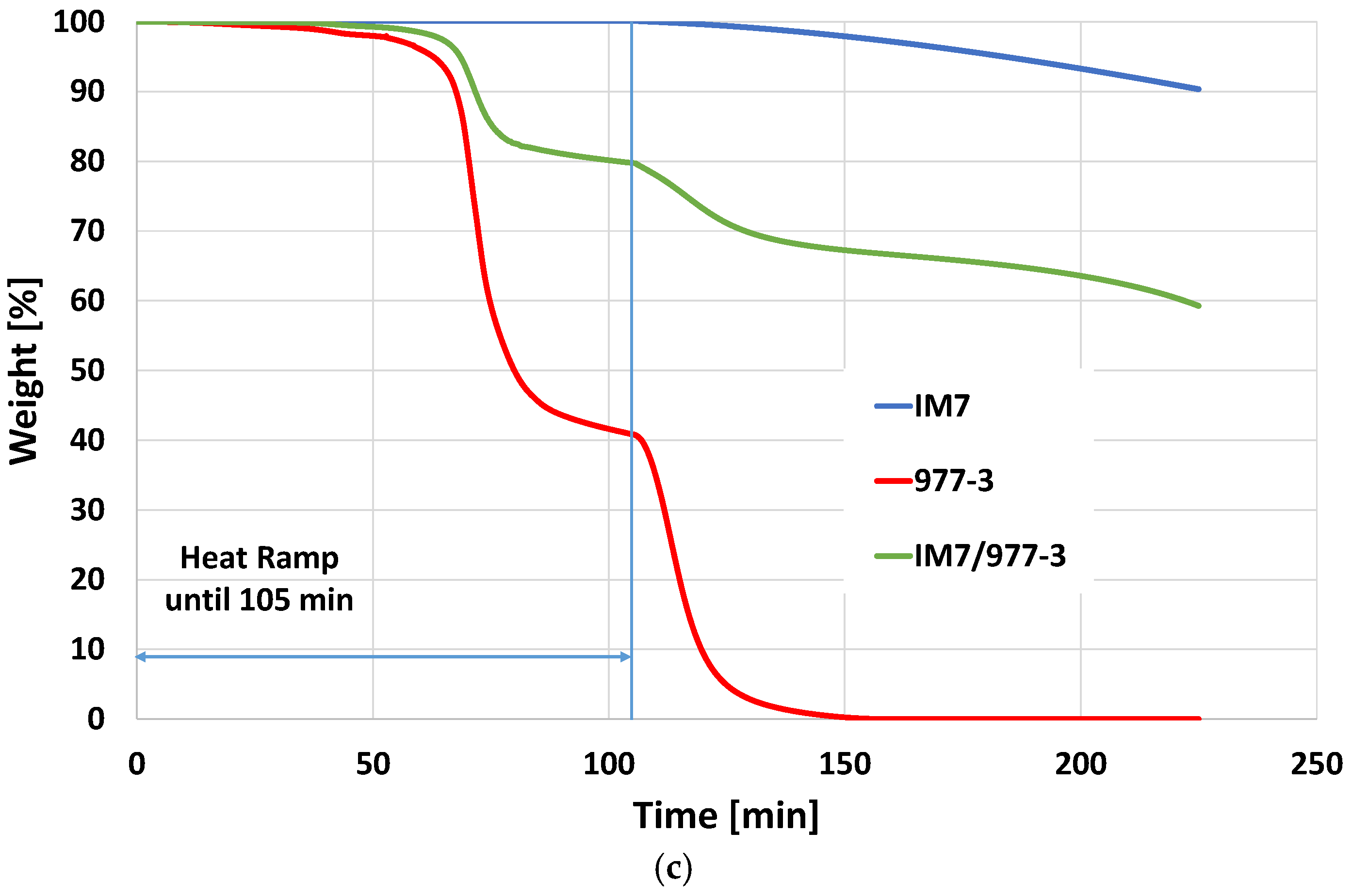
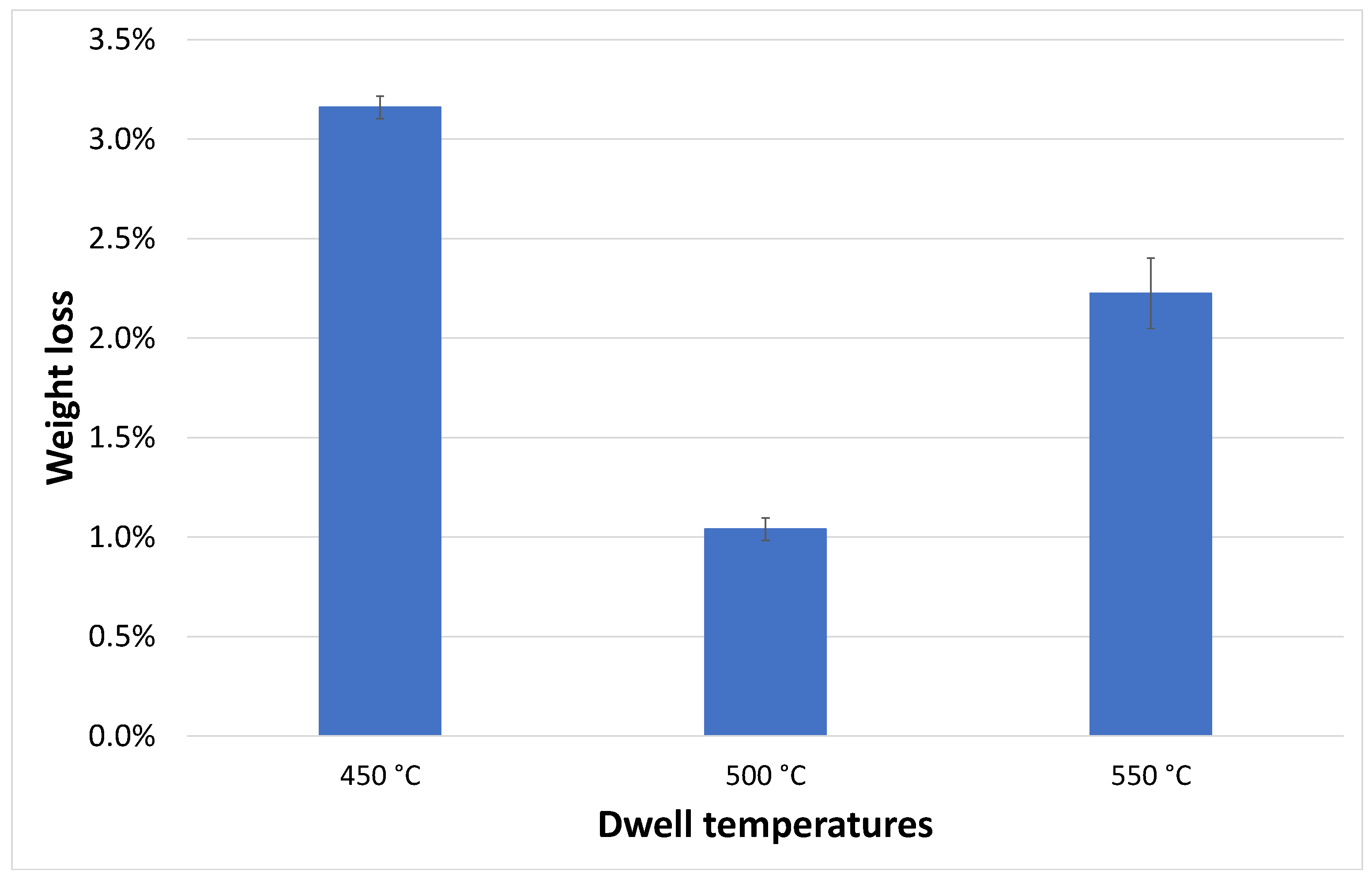



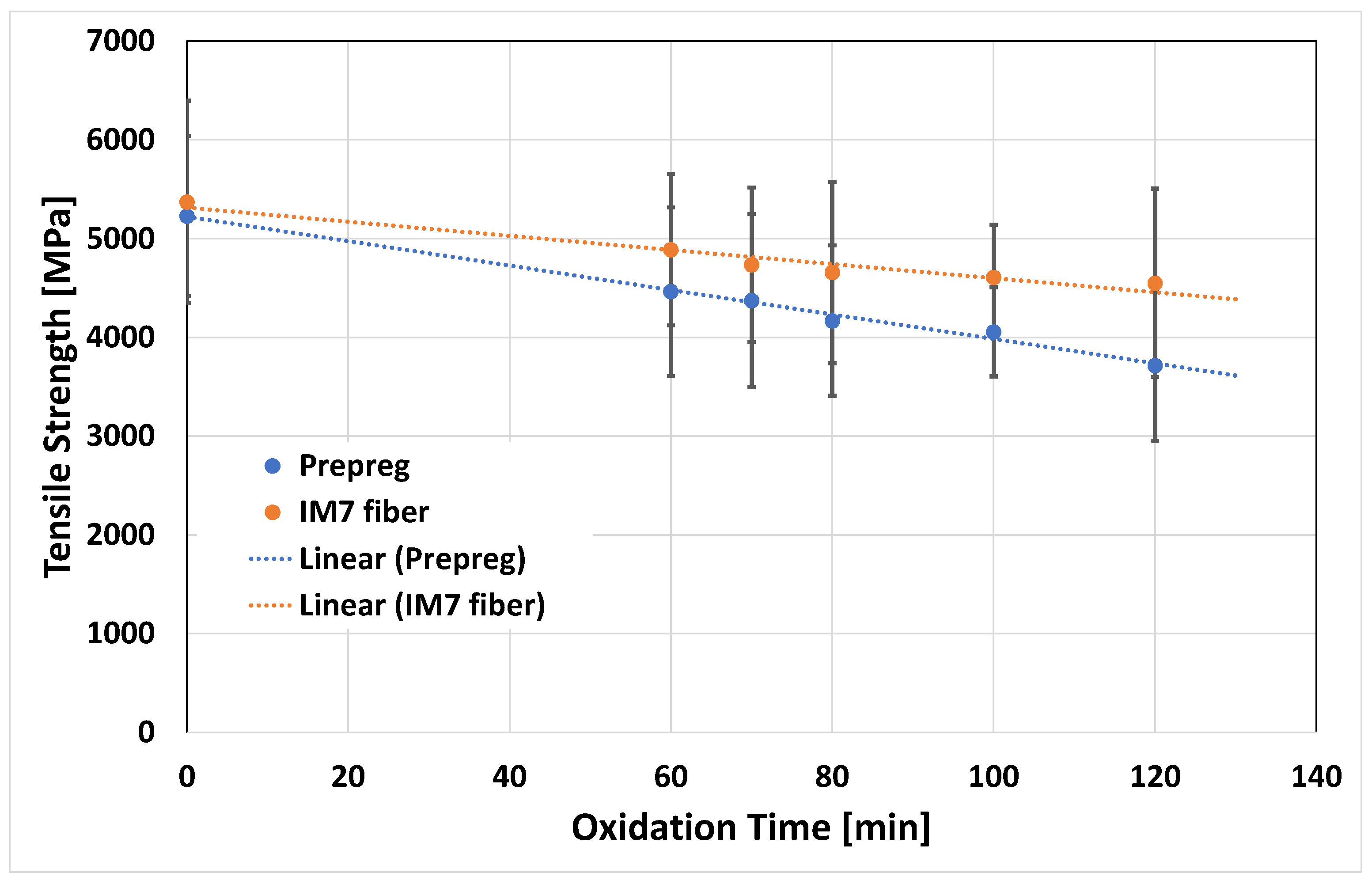
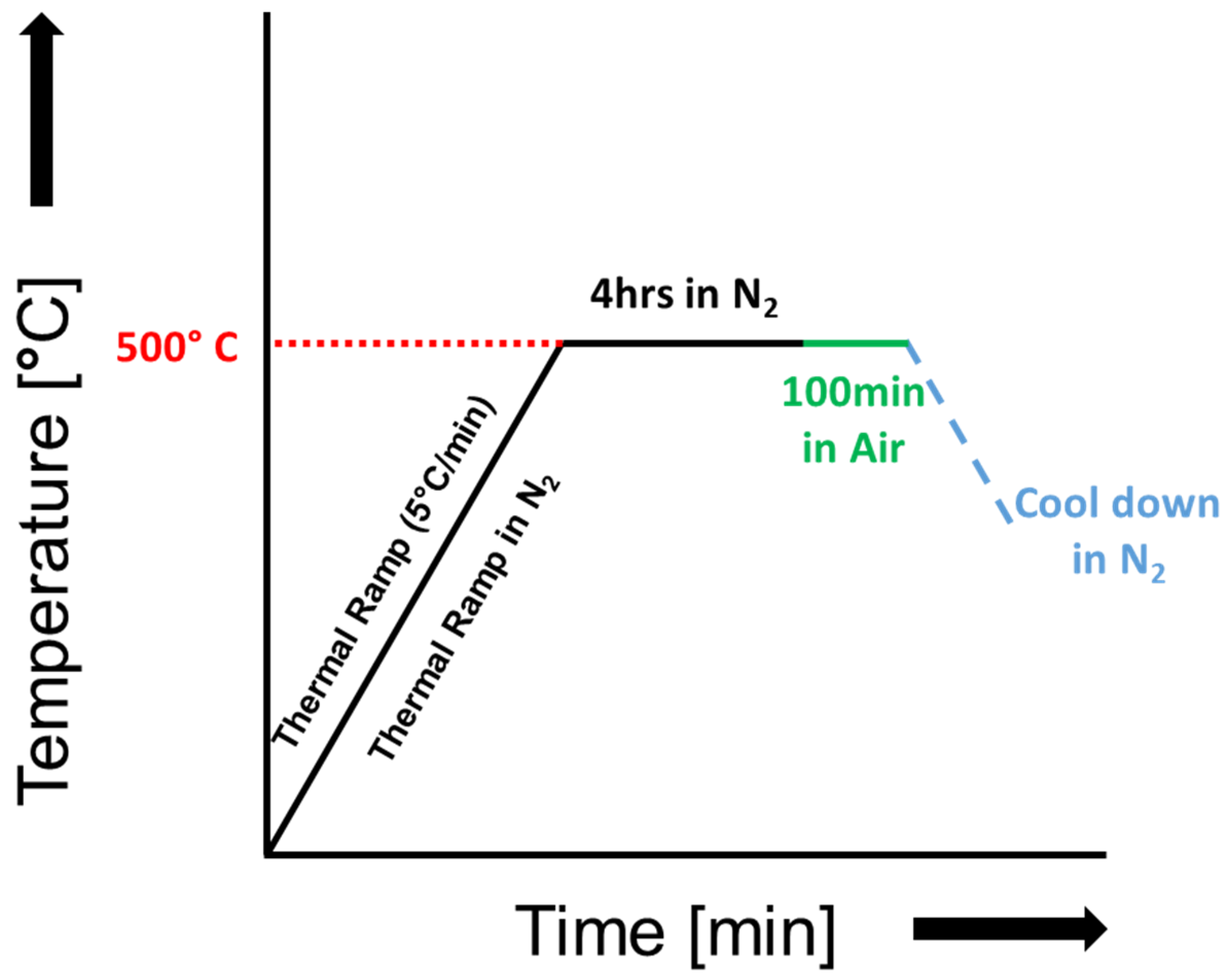

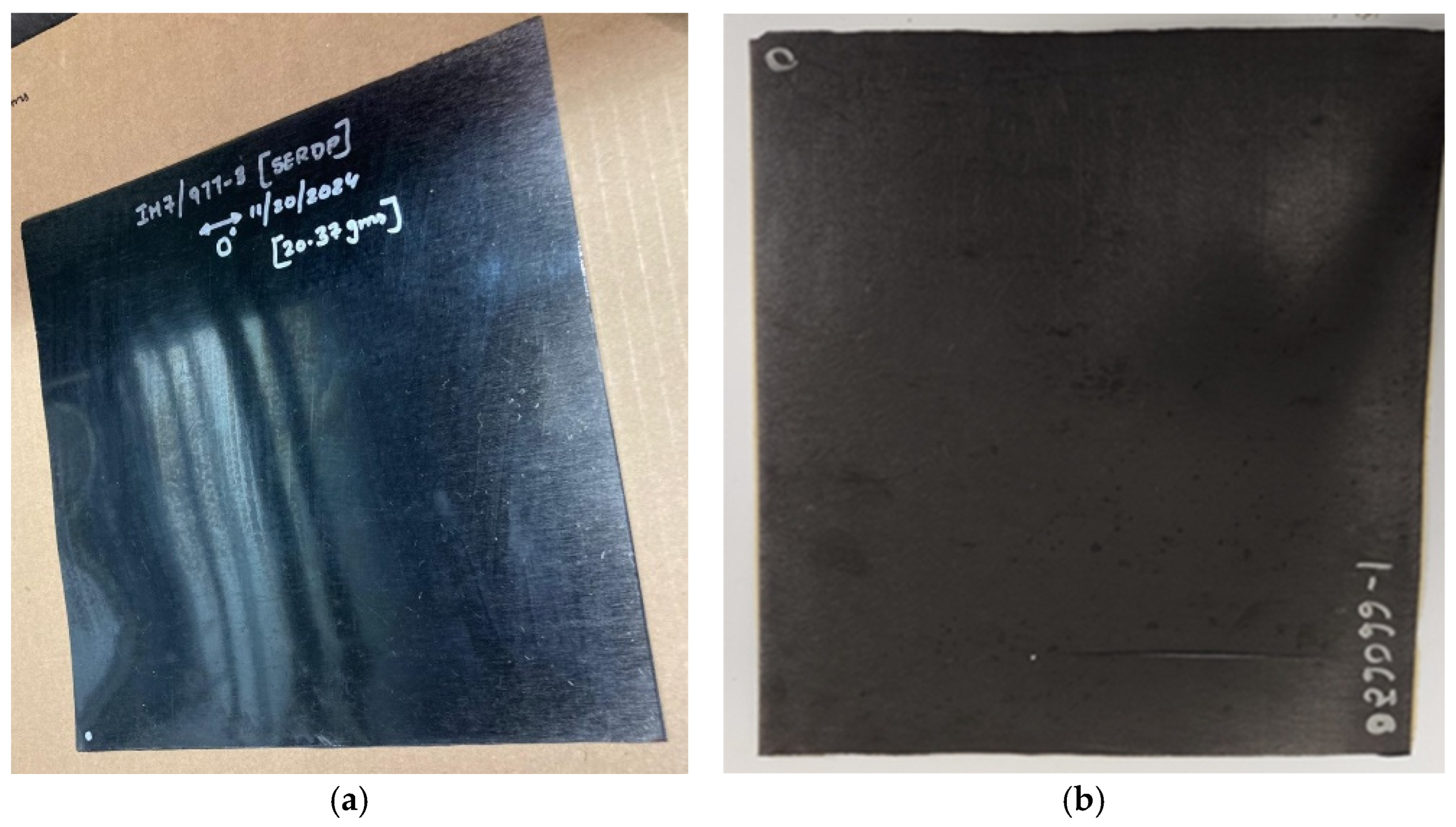
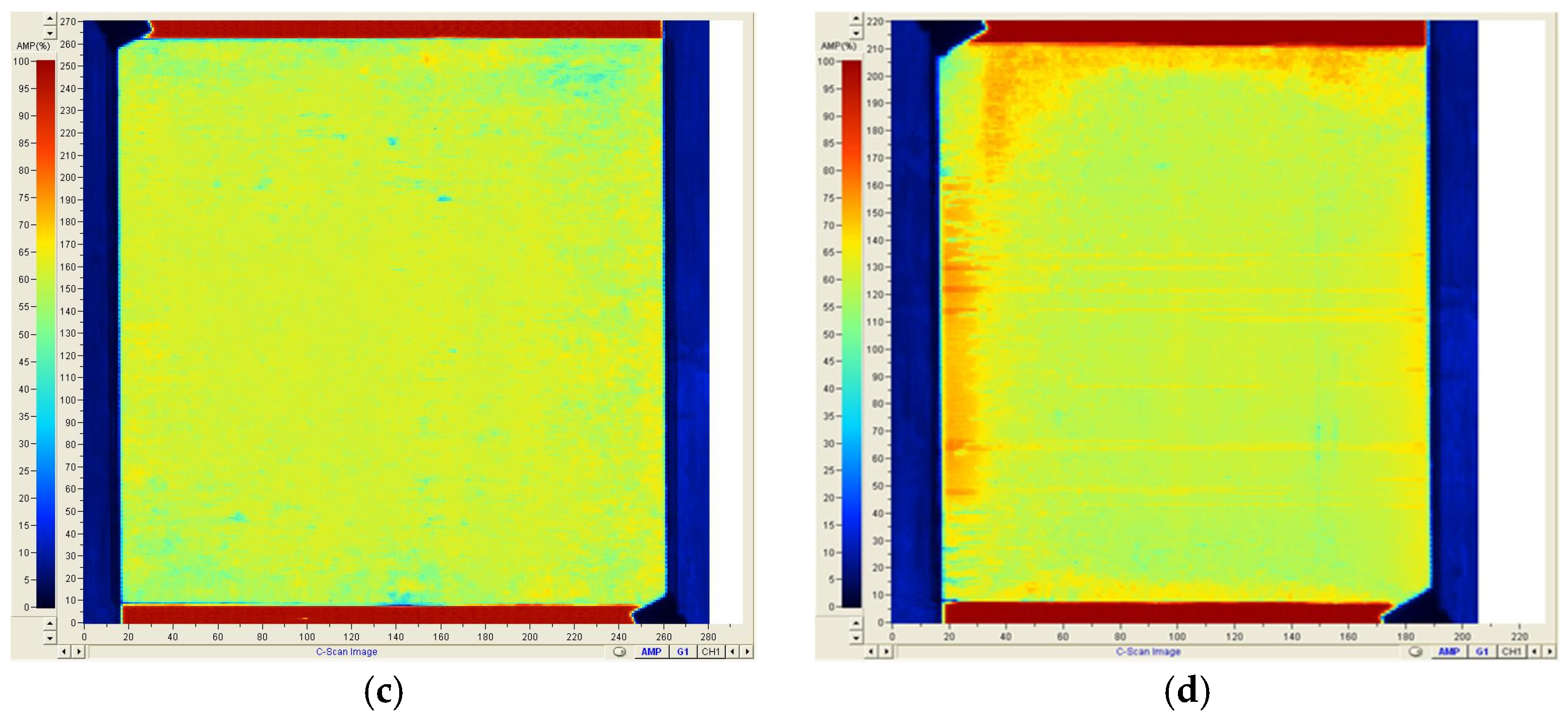

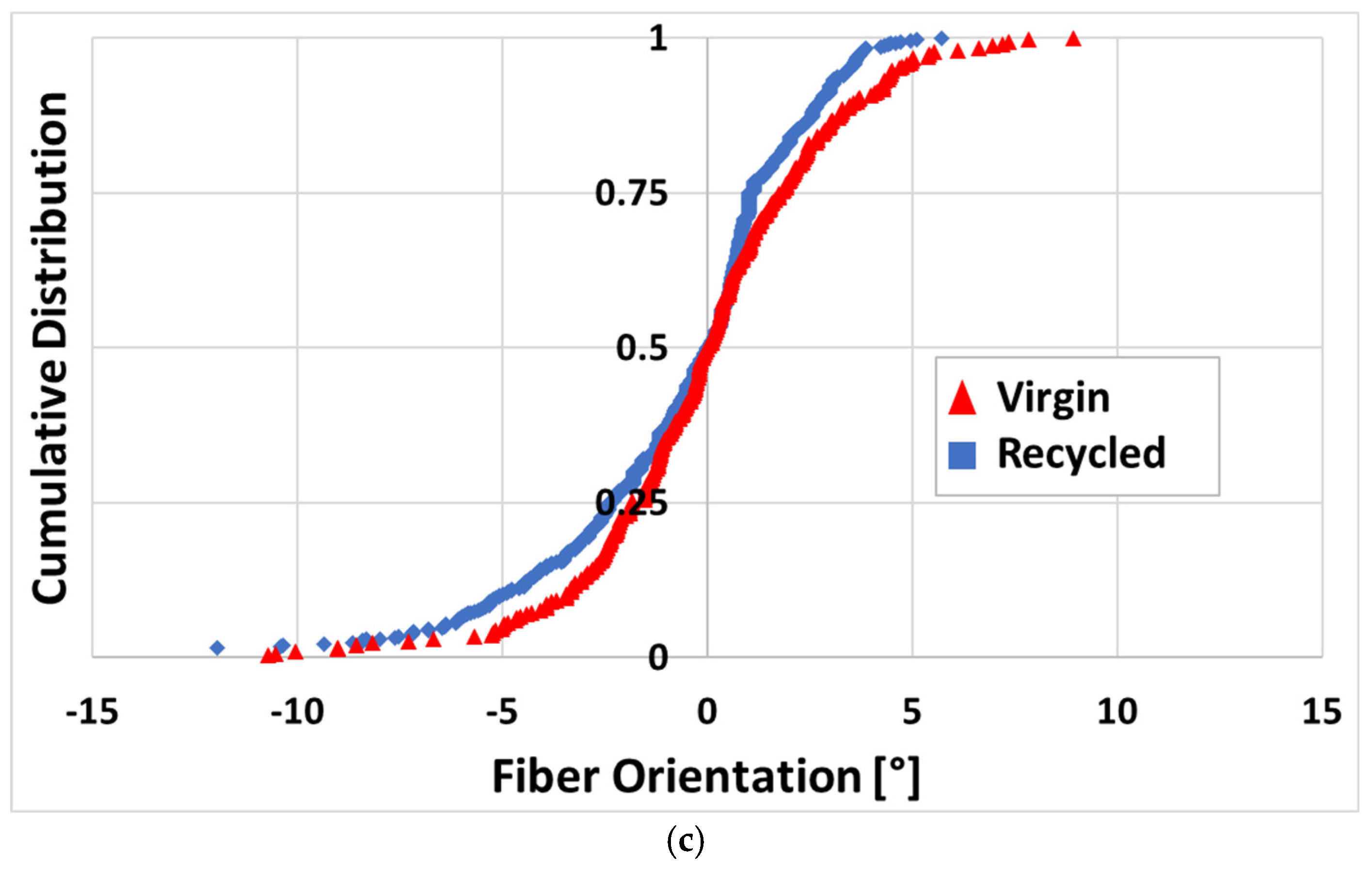
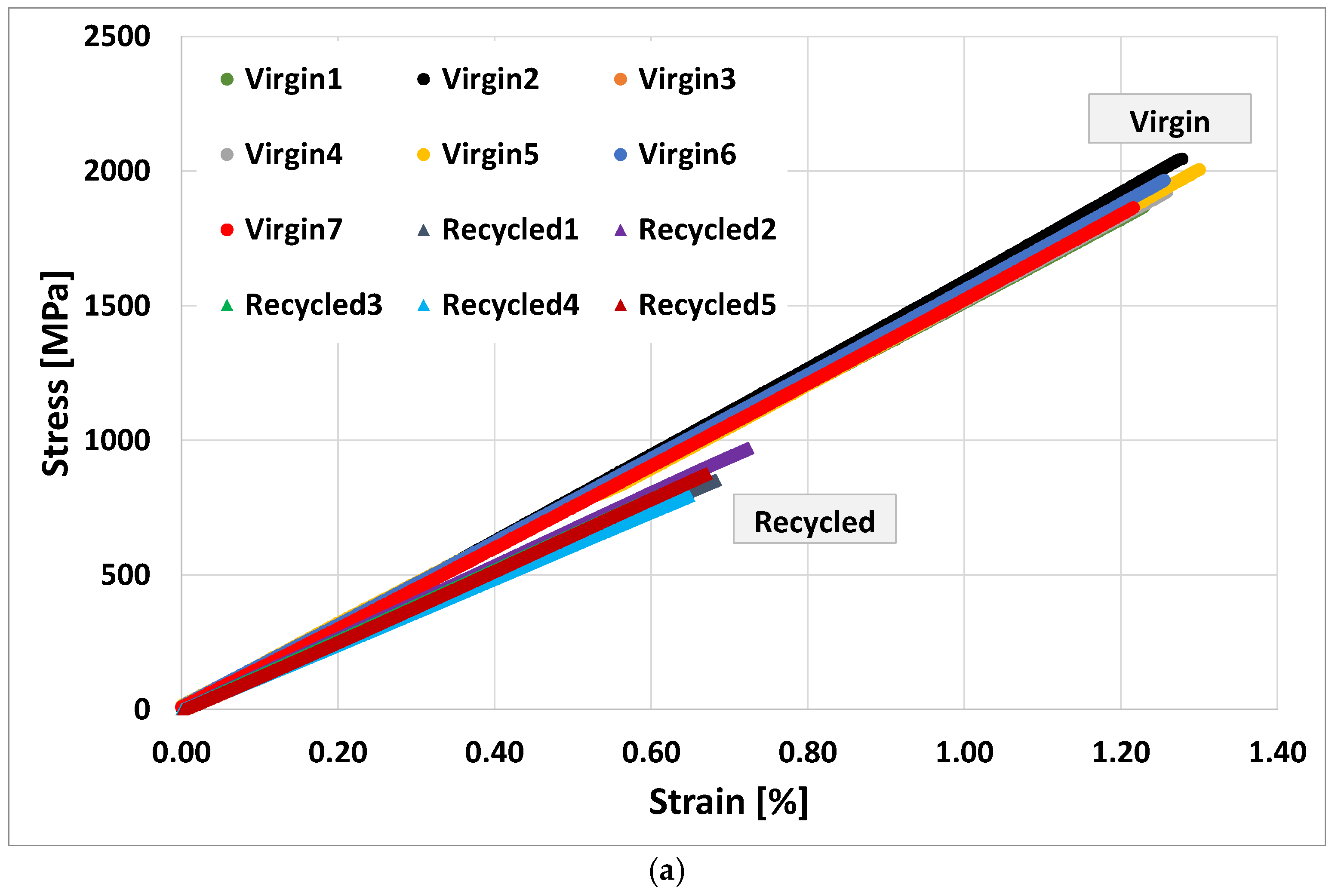



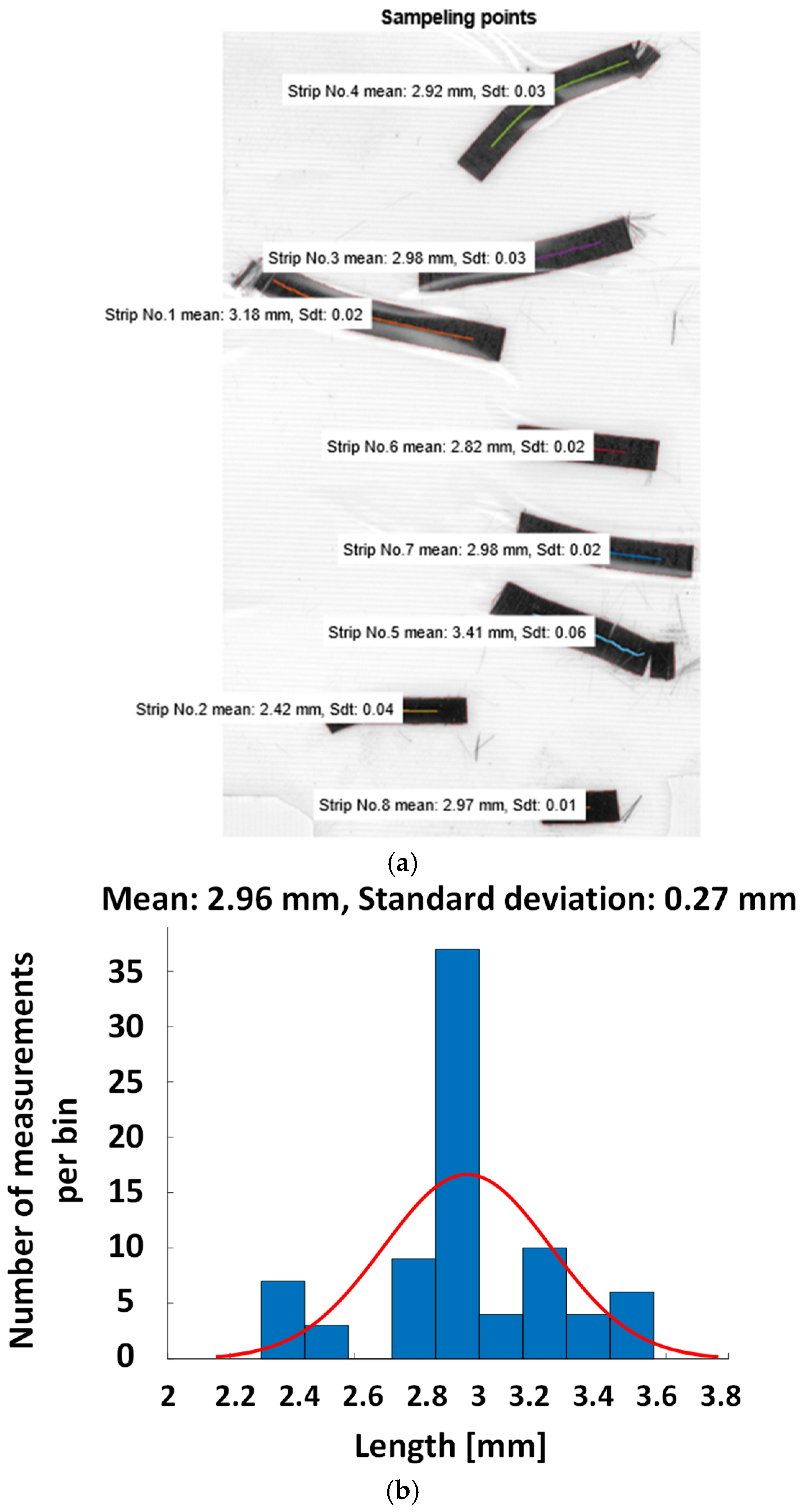
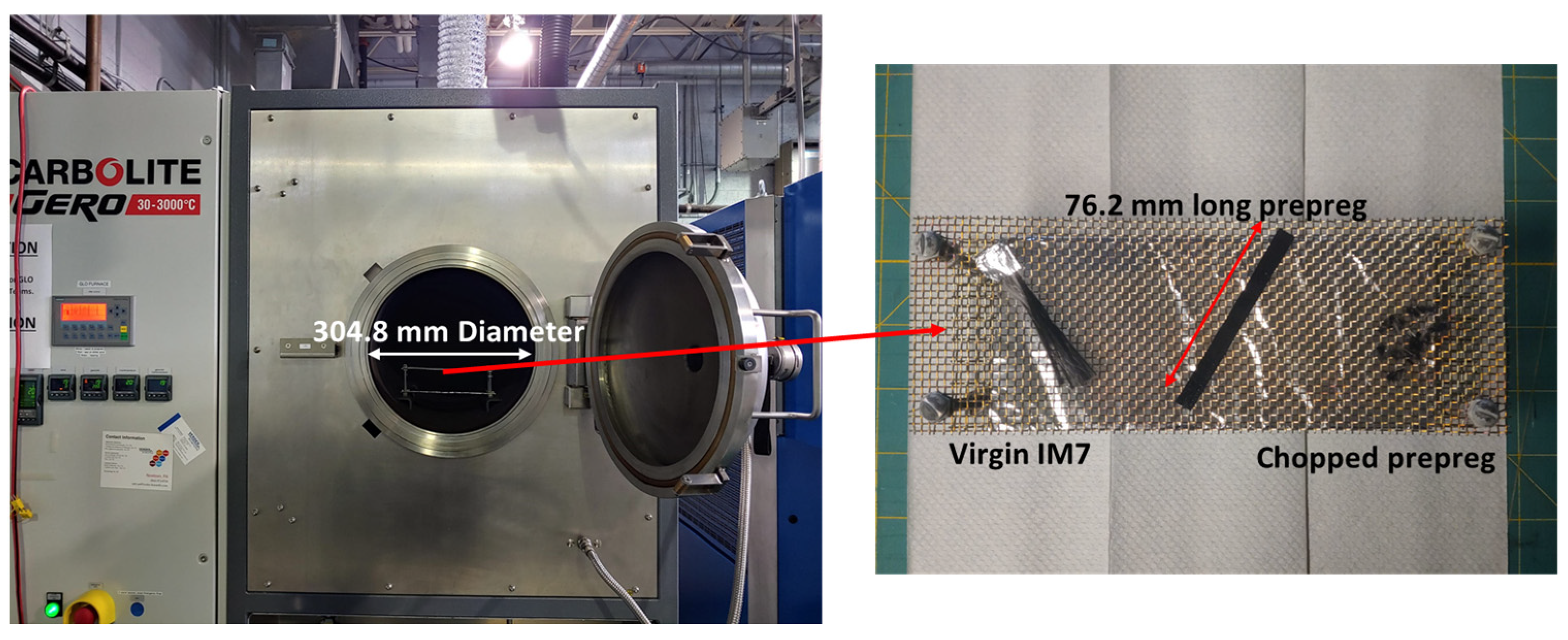
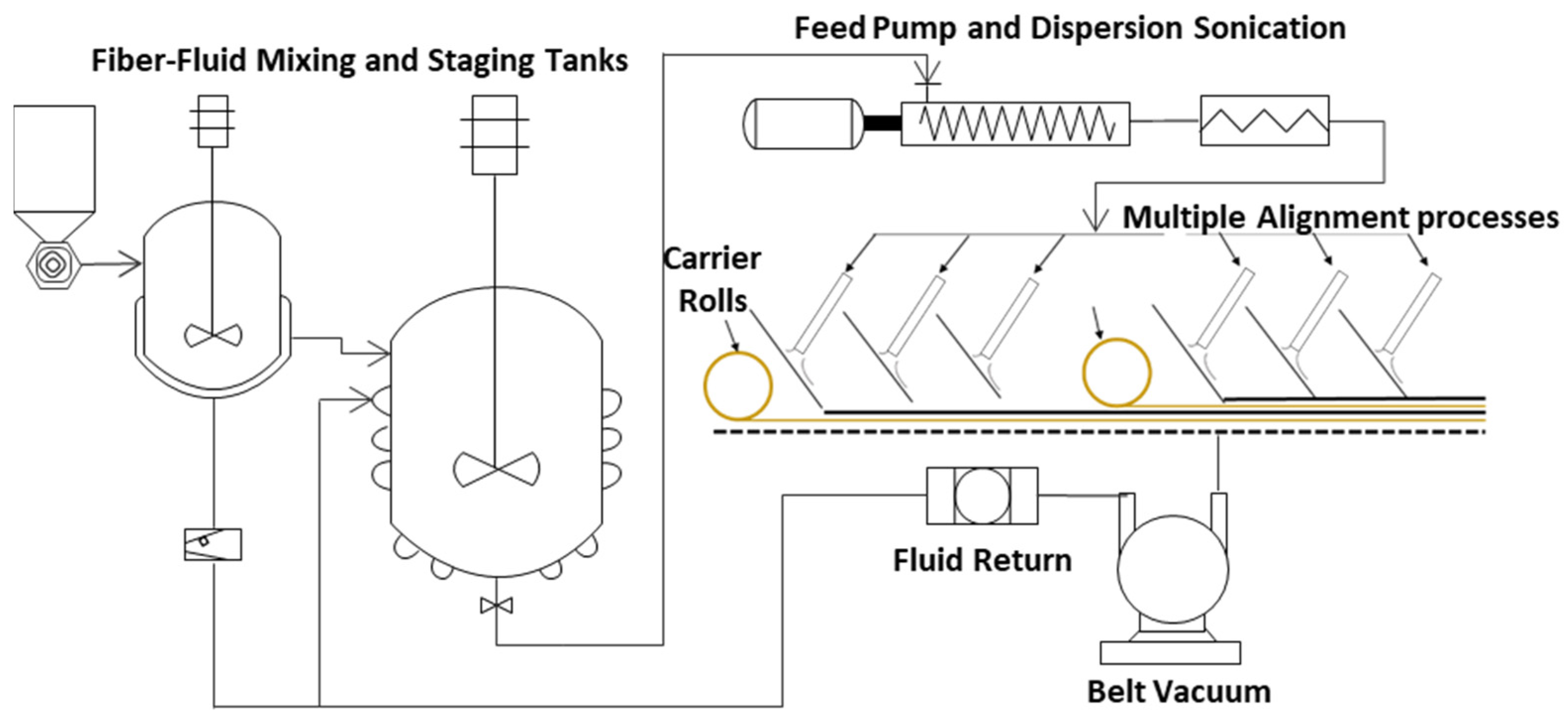
| 450 °C | 500 °C | 550 °C | ||
|---|---|---|---|---|
| 3% Resin residue | IM7 loss [%] | 3.3 | 0.7 | 1.0 |
| IM7 loss rate [%/min] | −0.02 | −0.02 | −0.05 | |
| Time in dwell [min] | 163 | 57 | 24 | |
| 2% Resin residue | IM7 loss [%] | 4.1 | 1.0 | 1.2 |
| IM7 loss rate [%/min] | −0.03 | −0.02 | −0.06 | |
| Time in dwell [min] | 197 | 71 | 29 | |
| 1% Resin residue | IM7 loss [%] | 6.1 | 1.6 | 1.6 |
| IM7 loss rate [%/min] | −0.03 | −0.02 | −0.07 | |
| Time in dwell [min] | 258 | 96 | 35 |
| ID | Material | Pyrolysis | Oxidation |
|---|---|---|---|
| ISO–1 | Prepreg (IM7/977-3) | 500 °C for 4 h in N2 | 500 °C for 0 min in Air |
| ISO–2 | Virgin IM7 | 500 °C for 4 h in N2 | 500 °C for 0 min in Air |
| ISO–3 | Prepreg (IM7/977-3) | 500 °C for 4 h in N2 | 500 °C for 60 min in Air |
| ISO–4 | Virgin IM7 | 500 °C for 4 h in N2 | 500 °C for 60 min in Air |
| ISO–5 | Prepreg (IM7/977-3) | 500 °C for 4 h in N2 | 500 °C for 70 min in Air |
| ISO–6 | Virgin IM7 | 500 °C for 4 h in N2 | 500 °C for 70 min in Air |
| ISO–7 | Prepreg (IM7/977-3) | 500 °C for 4 h in N2 | 500 °C for 80 min in Air |
| ISO–8 | Virgin IM7 | 500 °C for 4 h in N2 | 500 °C for 80 min in Air |
| ISO–9 | Prepreg (IM7/977-3) | 500 °C for 4 h in N2 | 500 °C for 100 min in Air |
| ISO–10 | Virgin IM7 | 500 °C for 4 h in N2 | 500 °C for 100 min in Air |
| ISO–11 | Prepreg (IM7/977-3) | 500 °C for 4 h in N2 | 500 °C for 120 min in Air |
| ISO–12 | Virgin IM7 | 500 °C for 4 h in N2 | 500 °C for 120 min in Air |
| Thermal Cycle | Strength [MPa] | St. Deviation [MPa] | Degradation [%] |
|---|---|---|---|
| ISO–1 | 5228 | 812 | 5 |
| ISO–2 | 5371 | 1025 | 3 |
| ISO–3 | 4463 | 852 | 19 |
| ISO–4 | 4887 | 767 | 11 |
| ISO–5 | 4372 | 875 | 21 |
| ISO–6 | 4735 | 782 | 14 |
| ISO–7 | 4168 | 761 | 24 |
| ISO–8 | 4656 | 919 | 16 |
| ISO–9 | 4055 | 452 | 26 |
| ISO–10 | 4608 | 531 | 16 |
| ISO–11 | 3715 | 762 | 33 |
| ISO–12 | 4550 | 954 | 18 |
Disclaimer/Publisher’s Note: The statements, opinions and data contained in all publications are solely those of the individual author(s) and contributor(s) and not of MDPI and/or the editor(s). MDPI and/or the editor(s) disclaim responsibility for any injury to people or property resulting from any ideas, methods, instructions or products referred to in the content. |
© 2025 by the authors. Licensee MDPI, Basel, Switzerland. This article is an open access article distributed under the terms and conditions of the Creative Commons Attribution (CC BY) license (https://creativecommons.org/licenses/by/4.0/).
Share and Cite
Balaga, U.K.; Gunes, A.; Ozdemir, T.; Blackwell, C.; Davis, M.; Sauerbrunn, S.; Fuessel, L.; Deitzel, J.M.; Heider, D. Optimization of the Recycling Process for Aligned Short Carbon Fiber TuFF Composites. Recycling 2025, 10, 55. https://doi.org/10.3390/recycling10020055
Balaga UK, Gunes A, Ozdemir T, Blackwell C, Davis M, Sauerbrunn S, Fuessel L, Deitzel JM, Heider D. Optimization of the Recycling Process for Aligned Short Carbon Fiber TuFF Composites. Recycling. 2025; 10(2):55. https://doi.org/10.3390/recycling10020055
Chicago/Turabian StyleBalaga, Uday Kiran, Aydin Gunes, Tekin Ozdemir, Chris Blackwell, Mark Davis, Steven Sauerbrunn, Lukas Fuessel, Joseph M. Deitzel, and Dirk Heider. 2025. "Optimization of the Recycling Process for Aligned Short Carbon Fiber TuFF Composites" Recycling 10, no. 2: 55. https://doi.org/10.3390/recycling10020055
APA StyleBalaga, U. K., Gunes, A., Ozdemir, T., Blackwell, C., Davis, M., Sauerbrunn, S., Fuessel, L., Deitzel, J. M., & Heider, D. (2025). Optimization of the Recycling Process for Aligned Short Carbon Fiber TuFF Composites. Recycling, 10(2), 55. https://doi.org/10.3390/recycling10020055








